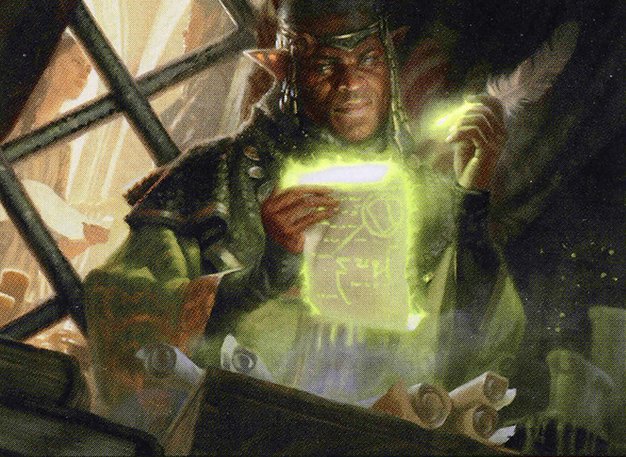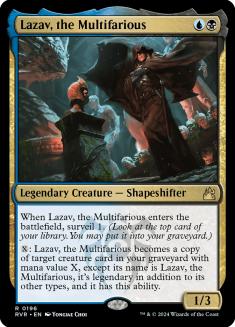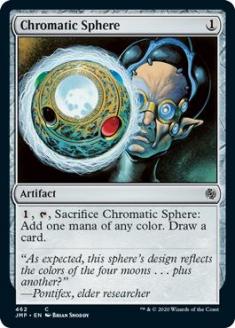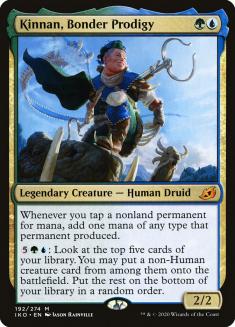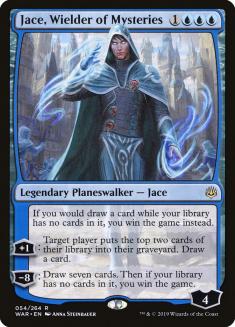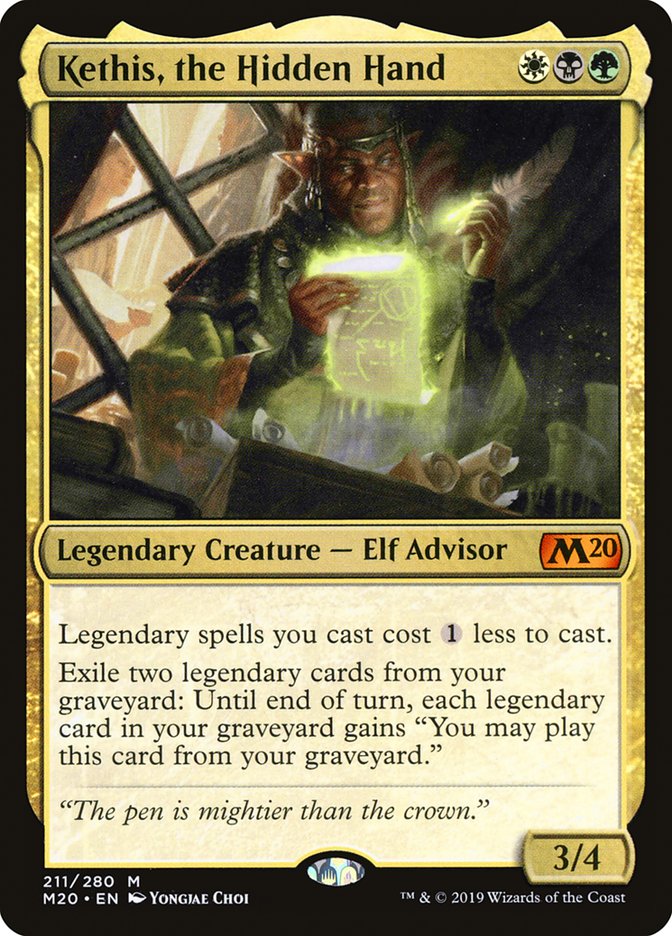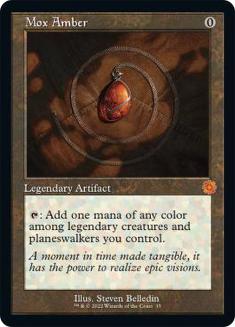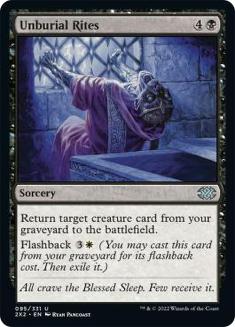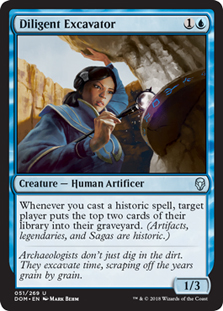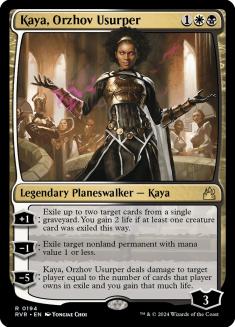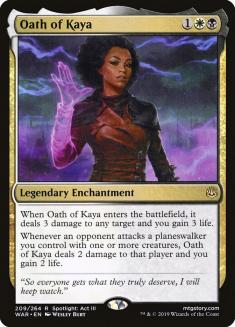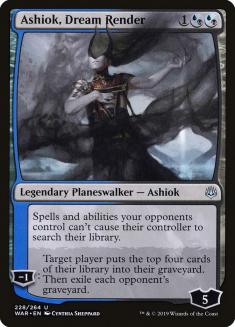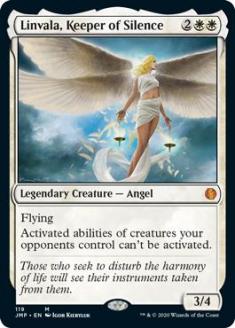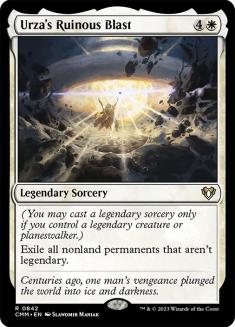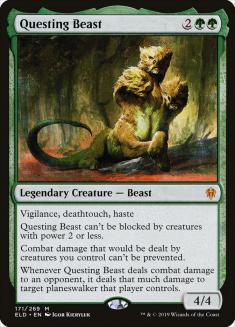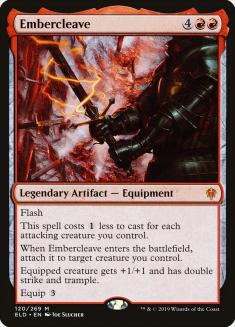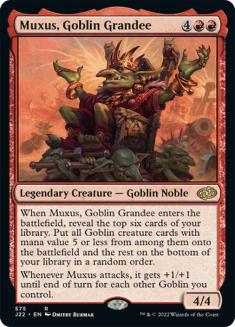Nexus of Fate is dead, long live Nexus of Fate! As the sun sets on one broken combo deck in Historic, it rises on another:
Creatures (22)
- 1 Teshar, Ancestor's Apostle
- 4 Diligent Excavator
- 4 Kethis, the Hidden Hand
- 3 Gilded Goose
- 4 Emry, Lurker of the Loch
- 1 Uro, Titan of Nature's Wrath
- 2 Lurrus of the Dream-Den
- 3 Kinnan, Bonder Prodigy
Planeswalkers (4)
Lands (25)
Spells (9)

There’s a lot going on in this iteration of Kethis Combo, and a good chunk that deviates from previous builds.
The largest shift in this deck is a domino effect that resulted in the departure of archetype mainstay Lazav, the Multifarious. This is a conscious decision to move away from the redundancy that Lazav offers, and into the explosiveness that fast mana can provide. This shift all started with one innocuous tool from Jumpstart:
Before Chromatic Sphere entered the fray, one of the biggest issues with Kethis Combo was that it lacked the speed to really be a better iteration of its Standard self. This is largely on the back of Emry, Lurker of the Loch not being good enough. With only Mox Amber to reduce Emry’s cost, comboing with Kethis was far more reliant on Diligent Excavator.
Chromatic Sphere’s introduction into Historic gave Emry decks access to a watered-down Mishra’s Bauble to turn her into a real card advantage engine when left unchecked. Emry-as-a-draw-engine isn’t the only technology that can be borrowed from Modern:
Once the deck has reached the point of leaning into Emry as a focal part of the deck, it’s important to make sure that she’s castable on Turn 2. A quick perusal of cheap artifacts available in Historic is a dry well without leaning into far less efficient card draw such as Soul-Guide Lantern and Terrarion. Despite not being a payoff card to work with Emry, Gilded Goosebrings her online on Turn 2 without actually sacrificing a ton in the way of power. Gilded Goose being both an accelerant and a mana-fixer is huge.
Fixing the manabase to account for Gilded Goose inadvertently also encourages another upgrade: color-optimization. As Michael Majors touched on in his introduction to Historic combo, the mana of traditional Kethis decks is absolutely rancid. Compound that with the fact that so much of Historic is dominated by aggressive strategies, and it’s easy to see why that just doesn’t cut it.
Making Gilded Goose work in a deck like this necessitates a shift in how the manabase, and by extension its spell lineup, is constructed. Supporting more than ten sources of untapped green mana on the first turn is tough, and it requires bending the deck to accompany all of these extra green mana sources.
Starting to see all of the signs that point towards Kinnan? At the point that the deck has a hair under a dozen ways to make use of Kinnan’s mana trigger, it starts to feel like something akin to Manamorphose. That’s to say it’s frequently free (or better) in terms of mana cost-to-gain, but the synergies of the deck push it more into Dark Ritual-with-upside territory. It seriously can’t be understated just how powerful it is to turn Chromatic Sphere’s ability into a cantripping Lotus Petal.
The shift from Lazav to Kinnan also signifies an emphasis being placed on explosiveness over redundancy, a symptom of today’s Historic format. Finding the sweet spot between aggro decks and ramp decks that can go over the top of everything is more about speed than it is resistance to spot removal.
The other aspect of Lazav that people are quick to mention is the selection that comes with the surveil trigger. To those people, I’d argue that Kinnan’s activated ability comes up more than one would assume. Diligent Excavator is the only creature in the maindeck that isn’t a hit, with Kethis himself being an Elf. Not hitting Mox Amber is naturally a real drawback, but this iteration of the deck uses Emry and Lurrus to such great effect that it isn’t as enormous issue.
To address the elephant in the room, Jace, Wielder of Mysteries is training wheels. Without any free anti-mill cards (think: Nexus of Fate) seeing play in the format, having a committed kill condition isn’t necessary. Diligent Excavator gets the job done on its own, as long as the Kethis pilot can click through the combo fast enough.
For anybody new to the deck: the Standard version of Kethis would win the game by decking itself with a couple of copies of Diligent Excavator. After decking itself, it would then use its fully stocked graveyard to recur a bunch of Diligent Excavators via Tamiyo, Collector of Tales or Teshar, Ancestor’s Apostle and then start pointing all the new mill triggers at the opponent.
The biggest struggle was pulling it off before roping on Arena. Normally, when taking game actions, each action will add a bit of time to the rope. However, if a turn takes long enough, the rope will eventually stop refueling and will automatically end a player’s turn if they take too long.
To anybody new to the deck, playing Jace over Uro in the deck is fine, but not a great place to be in the long run. Ultimately, the goal is to have the most streamlined deck possible. Jace is really only valuable as a kill condition, as it otherwise muddies the manabase and is fairly low-impact relative to its mana cost.
Part of what makes the shift to Diligent Excavator so much more reliable is the inclusion of Lurrus of the Dream-Den over Tamiyo, Collector of Tales. Mid-combo, Lurrus fits rather well as a pseudo-free couple of Excavator triggers. Outside of it, it also helps build Mishra’s Baubles with Chromatic Sphere in the same way that Emry does.
Oh, the free bit?
While mid-Kethis combo, Lurrus only costs two mana. Kinnan makes Mox Amber produce two. Lurrus casts another Mox Amber.
Between that interaction and Teshar, Ancestor’s Apostle, this should create a loop with Diligent Excavator to mill the opponent for any even number of cards. To cheat my own word count a bit with some words from Michael Majors on the same subject earlier this week:
Now for the life of me, I can’t figure out how to get this work on Arena. I’ve even been mocked by Sparky for ten minutes trying to figure out how to ensure picking the correct Lurrus to make the combo work. A Google search found a Reddit thread that helped enforce my theory that this is a bug and I’m in fact, not crazy and/or an imbecile.
Once the bug is fixed, a couple copies of Lurrus isn’t a big ask for a deck that sees so much of its library, especially for a backdoor combo with cards the deck was already interested in. In the meantime, Kethis Combo will simply have to settle for “one of the best creatures ever printed.”
Admittedly, Unburial Rites is a bit of a concession to how much better this deck is at milling itself as opposed to stacking its own library. Having a copy of Unburial Rites in the deck means it’s possible to win from the graveyard and get a combo off the ground with Teshar or Kethis.
This slot has teetered between the second copy of Teshar and the first Unburial Rites. As it stands, having a concrete resource that can be hit off Diligent Excavator or Emry during the developmental stages of the game is great.
The Sideboard
At this point, the sideboard is still somewhat a work in progress. With Historic developing new technology at a lightning-fast pace, most of what’s relevant is understand what goes where, what roles different cards serve during sideboarding, and what might not be as untouchable as previously assumed.
Against slower, grindy decks for example, I’m quick to trim a copy of Diligent Excavator and cut Gilded Goose entirely. Excavator isn’t particularly helpful at interacting early and is similar to Jace, Wielder of Mysteries in that it’s only wholly necessary mid-combo.
Gilded Goose becomes worse in grindier matchups because the speed isn’t the most important thing anymore. Having a card that dies to all the sweepers everything else does is a real liability when a full piece of cardboard was invested into it.
That doesn’t even get into the fact that Gilded Goose will never help you outrace Grafdigger’s Cage.
Kinnan, Bonder Prodigy is also justifiably trimmed in longer games, as the mana advantage is less pronounced when the deck has enough lands to just hit all of its land drops anyway.
Uro is reasonable against the creature decks of the format but is wholly underwhelming against anything combo-adjacent. That’s because those decks aren’t going to fold to a giant attacking knucklehead, and it’s rare that the investment demanded to keep Uro is going to be worth it. Even the ramp decks have Field of the Dead to completely blank it in combat, and the way that most of them are attacking the matchup is through graveyard hate anyway.
Teferi, Time Raveler stinks against the all-out aggro decks of the format. Nobody wants to tack “gain one life” onto a Repulse against a deck full of one-drops. He’s fine against Gruul because they have mid-sized threats, but bench him against Gutterbones and Fanatical Firebrand.
Aether Gust is the best sideboard card in the format. Don’t leave home without at least three. Having applications against Gruul Aggro; Temur Reclamation; and Nissa, Who Shakes the World decks is what makes the slots not feel like a waste, but its efficacy against Goblins is what makes the fourth a slam dunk. Have you ever Aether Gusted a spell that the opponent sacrificed their entire battlefield to cast? It is truly intoxicating.
This is one of the slots I’m the least sure of at the moment. Ooze’s biggest draw is that it wears a lot of hats and can completely shift the texture of a game on its own. Being a hate piece in the mirror, as well as card to bring in against creature decks, makes it worth being the fifteenth card in the sideboard. The deck is slanted to compensate for a green mana creature as it is, so I’m not too worried about being able to have a couple of green mana lying around to make use of it. It certainly isn’t something that will eat an entire graveyard on its own.
Kaya occupies a similar space as Scavenging Ooze while playing better to what Kethis wants out of its cards. Specifically, it has “Legendary” in its type line, while also being an interactive piece against certain kinds of decks. On top of being a reasonable way at shredding a graveyard over a long game, Kaya is a permanent answer to one of the most difficult cards for Kethis Combo to beat: Grafdigger’s Cage.
Having a card that can hit one of the most impactful graveyard hate cards in the format while also taxing other resources is unreal. Whether it’s tagging Llanowar Elves, Witch’s Oven, Mox Amber, or just Shark Typhoon tokens, Kaya as a recurring answer to threats and floodgates alike earns her keep in the sideboard.
As a legendary copy of Lightning Helix, Oath of Kaya is normally quite popular in Kethis. The biggest problem it has right now is that it is competing with Aether Gust, and with Gruul Aggro being the most prevalent aggro deck in the format, Oath of Kaya’s damage frequently isn’t good enough. Sure, being able to tag Bonecrusher Giant is great, but dying to Questing Beast while staring at an ineffective three-drop in hand ain’t a way to live.
One of the applications it does have, however, is that it can provide a source of card advantage in creature matchups with Teferi, Time Raveler in the same way it’s been doing in Standard for the last year or so. This interaction is also a great way to turn the corner in games where the deck is playing a fairer control role.
It’s hard to spell out all of the reasons that Ashiok is great without simply reading the card, so I’ll save you the graveyard hate and anti-Cultivate spiel. The great thing about Ashiok in specifically Kethis is that it is to graveyard hate what Kaya is to small-ball removal, but better. That’s to say Ashiok works as a reactive card against the strategies its effects line up well against, while also playing as an enabler for a deck that’s interested in milling itself. The opponent’s graveyard is exiled no matter who Ashiok targets, after all.
At this point the biggest places it’s being brought in are the mirror and the Field of the Dead matchups. Past that, Ashiok’s only real application is against the versions of Rakdos Sacrifice that are graveyard-centric enough to play Stitcher’s Supplier.
Linvala, Keeper of Silence is a real “the bottom tastes the same as the top” situation. That’s to say she was in the first iteration of the deck that I picked up from @Jaywmtg, but I found her to be about a turn too slow against the deck she’s most wanted for: Goblins. That was before moving to Kinnan and Gilded Goose, however.
This shift pushes up the turn that Linvala hits the battlefield, and gives her a ton of game against both Goblins and the mirror. What’s worth noting is that both of these decks aren’t completely cold to Linvala, sporting Gempalm Incinerator and Teferi, Time Raveler, respectively. Regardless, she is a great floodgate that only goes one way, with applications against creature-based ramp as well.
So close to a one-sided Akroma’s Vengeance that it’s not even reasonable. Did I mention it can be cast from the graveyard with Kethis?
Despite Urza’s Ruinous Blast not being as mana-efficient as something like Shatter the Sky, combo decks like this one need to have a raw density of cards to exile in order to have a functional plan to win the game. Paying a slight premium on a sweeper is perfectly fine (that goes double when considering the recursive element).
The biggest issue lies in some of the permanents it does not deal with. Remember that this card mostly will see use against decks where it will tag three or more permanents at a time; otherwise the downside of its cost isn’t really worth it. A ton of aggressive strategies have begun to unintentionally lean into permanents that Urza’s Ruinous Blast isn’t great at dealing with, which creates room to explore other anti-aggro cards in its place.
For now it’s the best card for the job, but that doesn’t mean it isn’t on thin ice.
Constant Exploration
For now, a Bant-rooted version of Kethis Combo with Kinnan, Bonder Prodigy seems like the best version of the deck. Will that be true next week? It’s hard to say, with Historic being as wide-open as it is.
Mox Amber will likely be banned someday. When that happens, it’s up to you whether or not you look back and saw yourself winning with Mox Amber or losing to it. Getting practice with an archetype is irreplaceable when it comes to adapting, and with a deck as complex as Kethis, I gotta say, the sooner you start honing those skills, the better.

